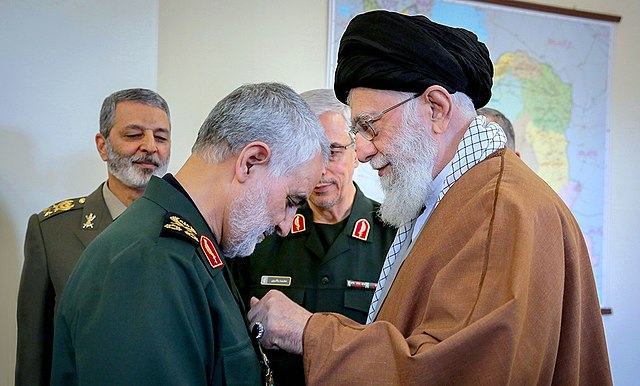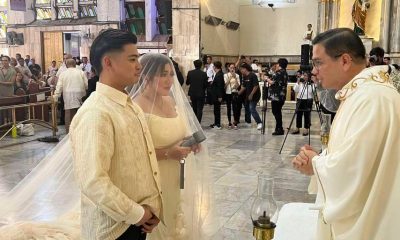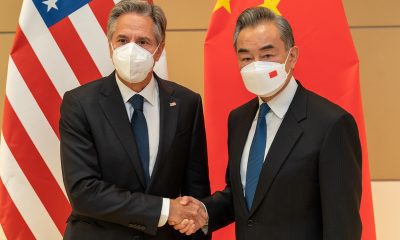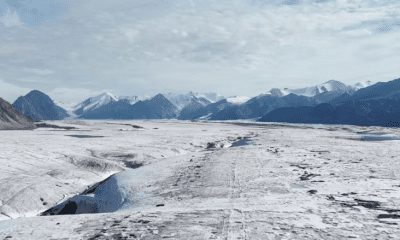News
Soleimani had sheltered al-Qaeda leaders, claims author

FILE: Soleimani receiving the Order of Zolfaghar from Ali Khamenei (Photo: Khamenei.ir, CC BY 4.0)
ANKARA — Although high-profile slain Iranian military leader Gen. Qasem Soleimani is known for extending Shia arc or Iranian influence beyond his country’s borders to Iraq, Syria, Lebanon, and up to Yemen, little is known that he had also sheltered fighters of al-Qaeda terrorist group and senior members of its military council, a British author claimed.
“Soon after the US-led military campaign began in Afghanistan that led to the overthrow of Taliban regime in Kabul, al-Qaeda’s top leader Mahfouz ibn Ali Walid, also known as Mauritanian, knocked at the Iranian border,” said Adrian Levy, a renowned British author and investigative journalist, in an exclusive interview with Anadolu Agency.
Soleimani, head of the elite Quds Force of the Islamic Revolutionary Guards Corps (IRGC), and Iraqi militia commander Abu Mahdi al-Muhandis were killed on Jan. 3 in a US airstrike on their convoy at Baghdad airport.
He led the foreign arm of the Revolutionary Guards and had a key role in fighting in Syria and Iraq, acquiring celebrity status at home and abroad.
Asked how the act fits into Soleimani’s image of a hardline Shia leader, Levy said he had laid hands on interrogation reports, letters and other communications of al-Qaeda leaders, proving their presence in Iran.
In his extraordinary inside story on al-Qaeda in the years after 9/11, the author in his book The Exile has chronicled the astonishing tale of evasion, collusion, and isolation of its leader Osama bin Laden.
Talking to Anadolu Agency from London, Levy said Mahfouz, the religious head of al-Qaeda, had approached Soleimani in December 2001, when Pakistan had joined the American war in Afghanistan.
”Previously, al-Qaeda had gone to Iraq seeking help but gained nothing from Saddam Hussein. The US would claim it was an Iraqi dictator who was their historic sponsor as one of the grounds for war in 2003,” he stated.
He said that even when the extremist group was shifting from Africa to Afghanistan, Iran had given various promises — then offering al-Qaeda training in the Beqaa Valley, alongside Hezbollah.
“So, when Mahfouz reached Taftan, crossing point into Iran in Balochistan province of Pakistan on Dec. 19, 2001, from Quetta, he was following a path used before and pushing on an open door. Quds Force wanted al-Qaeda leaders and Osama’s family for several reasons,” said the author, known for his investigative reports.
The exodus of al-Qaeda leaders began in March 2002. The Quds Force agents set up a desert refugee camp on the Afghan border.
“They were later escorted to Tehran, where women and children were put up at the four-star Howeyzeh Hotel on Tehran’s Taleqani Street, just down from the former US mission. Others stayed across the road at the Amir Hotel. They were issued papers presenting them as the Arab fighters and their families as Iraqi Shia refugees from the Iran-Iraq War,” said the author, quoting interrogation reports of various al-Qaeda fighters.
Engagement between US, Iran
At the Howeyzeh Hotel, there was room service, a ladies-only gym, movies, and a swimming pool for children. In the Amir Hotel, former fighters sat down together in comfort for the first time since 9/11.
Bin Laden’s family and several high-ranking al-Qaeda leaders — including group’s military chief Saif al-Adel — who were on the FBI’s most wanted terrorist list had arrived in Iran. Their letters show how they established a funding pipeline through Iran and began plotting new attacks, including the Riyadh compound suicide bombings of 2003 in which 39 people were killed.
Iran and the US were actively engaged through the backchannel throughout 2002 and in the first quarter of 2003 in a bid to seek normalization of relations. Iran had offered hand over of al-Qaeda leaders, members of religious council and family of bin Laden as a bargain and in return they were asking for safety and normalization.
But Dick Cheney, who served as the 46th vice president of the US from 2001-2009, refused.
“Those involved said he [Cheney] argued that after the US had dealt with Iraq it would deal with Iran and it did not require a deal,” said Levy.
“The Quds Force gathered the al-Qaeda leaders, their families, and family of Osama and moved them to Tehran — finally camped them inside their base. These people then became bargaining chips to protect Iran from attack and offered as gambits to other countries,” the author added.
Also, another reason for the US developing cold feet on Iranian offer was that the White House had deep skepticism about Quds Force and the IRGC. The US did not feel sure to trust Iran.
Asked why the US refused to take the easier route rather engaging in wars, the British author said at times countries benefit from enabling insurgencies far more than they do by quashing them.
Some al-Qaeda leaders spent 13 years in Iran
The Bush administration could have seized al-Qaeda’s religious council and part of its military council, and held almost all of bin Laden’s family to force al-Qaeda heads to come out into the open, as far back as in 2002. Instead, Bush accused Iraq of aiding the extremist group and possessing weapons of mass destruction to justify a long-held agenda to topple Saddam Hussein.
The author lamented that the war that had begun to make the US safe by offensive action after the 9/11 attacks had turned into an ideological war to reshape the Middle East.
“This chaotic process has not helped either to wrap up al-Qaeda or contain Osama’s family. The US has prolonged the chaos and it could be argued that it is responsible for the massive loss of life — to its servicemen and women — as well as civilians of the region,” he said.
Many of Al Qaeda’s leaders remained in Iran until the summer of 2015 when four of them were secretly flown to Damascus.
In 2016, after spending 13 years in Iran, military chief Saif al-Adel was quietly flown to Syria.
Bin Laden’s adult sons were with Saif al-Adel in Shiraz, accompanied by the operational planner Abu Mohammed al-Masri and by Mohammed al-Islambouli, whose brother Khalid had been executed for his part in the murder of the Egyptian President Anwar Sadat and whose daughter was married to Othman bin Laden.
Osama’s reluctant spokesman Sulaiman Abu Ghaith was hiding with a Sunni family in Zahedan. Also in Iran were the commander Abu Laith al-Libi and Thirwat Shihata, an aide to Aymen al-Zawahiri. (Anadolu)





















